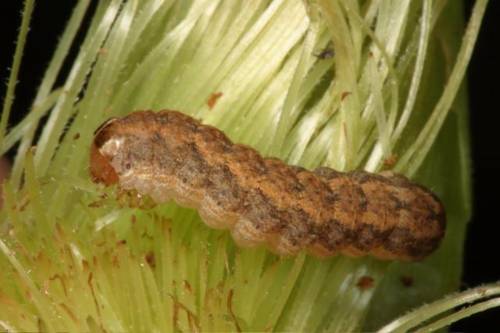Western Bean Cutworm
Richia albicosta
 Egg mass of western bean cutworm. |
Larva of western bean cutworm. |
This insect is an occasional problem in western Kansas. Adults have been collected also in traps in Hays, Great Bend, Scandia and Hiawatha, but so far larvae have not been found in corn fields in these areas. Careful scouting and timing of sprays are necessary to obtain adequate control.
Field scouting should begin at the first sign of tasseling and continue until the silks turn brown. Look for round white eggs in groups of 5 to 200 on the upper surface of the upper leaves. The eggs gradually become darker in coloration, hatching in five to seven days. Newly hatched larvae are pale with light-brown stripes running lengthwise down the back. Control measures are justified when eggs or small larvae are present on 8% of plants when corn is 95 percent tasseled. Control will be reduced if applications are delayed until all silks have emerged, or if larvae have already entered the ear tips. Typically, scouting should be conducted between July 18 and 30 in southwest Kansas, and about a week later in northwest Kansas.
Corn hybrids with Herculex I and Herculex XTRA (Containing the event TC 1507 with Cry1F) are said to provide adequate protection against larvae of the western bean cutworm and may be a consideration for producers who have experienced problems with this pest.
Please refer to the most recent version of the Corn Insect Management Guide for treatment options.
Page last updated 4/2/2024 by J.P. Michaud.
